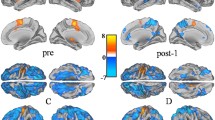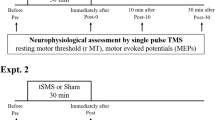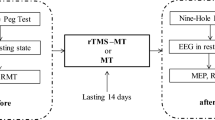Abstract
Repetitive transcranial magnetic stimulation (rTMS) affects cortical excitability according to the frequency of stimulation. Few data are available on the influence of rTMS applied over the primary motor cortex (M1) on motor performances in healthy volunteers. The aim of this study was to determine, through kinematic analysis, whether rTMS over the left M1 changes initiation and performance of movement executed with the contralateral arm. Nine healthy males completed a set of motor tasks, consisting of a single-joint rapid movement between two objects performed under three different behavioral conditions (self-initiated; externally triggered known, during which the subject could see where the target was positioned in advance; externally triggered unknown, during which the subject could not see where the target was positioned until he reached it). The tasks were performed in a randomized order in three different sessions, with a seven-day interval between each session: (1) without stimulation (baseline); (2) immediately after 1-Hz rTMS; (3) immediately after 10-Hz rTMS. We measured reaction time, movement time, calculated as the sum of the time taken to reach the target from movement onset (T1) and that taken to reach the target to movement termination (T2), acceleration and deceleration time on the velocity profile, as well as the ratio between them, and maximum speed and maximum acceleration. Reaction time, movement time, and T2 significantly increased after 1-Hz rTMS and decreased after 10-Hz rTMS, while the other parameters remained unchanged. Our results suggest that rTMS may modify both initiation and performance of a voluntary movement.







Similar content being viewed by others
References
Avanzino L, Bove M, Trompetto C, Tacchino A, Ogliastro C, Abbruzzese G (2008) 1-Hz repetitive TMS over ipsilateral motor cortex influences the performance of sequential finger movements of different complexity. Eur J Neurosci 27:1285–1291
Berardelli A, Hallett M, Rothwell JC, Agostino R, Manfredi M, Thompson PD, Marsden CD (1996) Single-joint rapid arm movements in normal subjects and in patients with motor disorders. Brain 119:661–674
Buxbaum LJ, Sirigu A, Schwartz MF, Klatzky R (2003) Cognitive representations of hand posture in ideomotor apraxia. Neuropsychologia 41:1091–1113
Chen R, Yaseen Z, Cohen LG, Hallet M (1998) Time course of corticospinal excitability in reaction time and self-paced movements. Ann Neurol 44:317–325
Cunnington R, Windischberger C, Deecke L, Moser E (2002) The preparation and execution of self-initiated and externally-triggered movement: a study of event-related fMRI. Neuroimage 15:373–385
Currà A, Berardelli A, Agostino R, Modugno N, Puorger CC, Accornero N, Manfredi M (1997) Performance of sequential arm movements with and without advance knowledge of motor pathways in Parkinson’s disease. Mov Disord 12:646–654
Currà A, Berardelli A, Agostino R, Giovannelli M, Koch G, Manfredi M (2000) Movement cueing and motor execution in patients with dystonia: a kinematic study. Mov Disord 15:103–112
François-Brosseau FE, Martinu K, Strafella AP, Petrides M, Simard F, Monchi O (2009) Basal ganglia and frontal involvement in self-generated and externally-triggered finger movements in the dominant and non-dominant hand. Eur J Neurosci 29:1277–1286
Fujiwara T, Rothwell JC (2004) The after effects of motor cortex rTMS depend on the state of contraction when rTMS is applied. Clin Neurophysiol 115:1514–1518
Gregori B, Currà A, Dinapoli L, Bologna M, Accornero N, Berardelli A (2005) The timing and intensity of transcranial magnetic stimulation, and the scalp site stimulated, as variables influencing motor sequence performance in healthy subjects. Exp Brain Res 166:43–55
Hallett M, Shahani BT, Young RR (1975) EMG analysis of stereotyped voluntary movements in man. J Neurol Neurosurg Psychiatry 38:1154–1162
Hammond GR, Fox CA, Allison M (2005) Electrophysiological evidence for lateralization of preparatory motor processes. NeuroReport 16:559–562
Hiraoka K, Sugiyama K, Abe K (2009) Effects of transcranial magnetic stimulation over the cerebellum on triphasic electromyographic pattern. Int J Neurosci 119:1523–1537
Irlbacher K, Voss M, Meyer BU, Rothwell JC (2006) Influence of ipsilateral transcranial magnetic stimulation on the triphasic EMG pattern accompanying fast ballistic movements in humans. J Physiol 574:917–928
Jahanshahi M, Jenkins IH, Brown RG, Marsden CD, Passingham RE, Brooks DJ (1995) Self-initiated versus externally triggered movements. I. An investigation using measurement of regional cerebral blood flow with PET and movement related potentials in normal and Parkinson’s disease subjects. Brain 118:913–933
Jäncke L, Steinmetz H, Benilow S, Ziemann U (2004) Slowing fastest finger movements of the dominant hand with low-frequency rTMS of the hand area of the primary motor cortex. Exp Brain Res 155:196–203
Liang N, Yamashita T, Ni Z, Takahashi M, Murakami T, Yahagi S, Kasai T (2008) Temporal modulations of agonist and antagonist muscle activities accompanying improved performance of ballistic movements. Hum Mov Sci 27:12–28
Lu MK, Arai N, Tsai CH, Ziemann U (2012) Movement related cortical potentials of cued versus self-initiated movements: double dissociated modulation by dorsal premotor cortex versus supplementary motor area rTMS. Hum Brain Mapp 33:824–839
Maeda F, Keenan JP, Tormos JM, Topka H, Pascual-Leone A (2000) Interindividual variability of the modulatory effects of repetitive transcranial magnetic stimulation on cortical excitability. Exp Brain Res 133:425–430
Meinck HM, Benecke R, Meyer W, Hohne J, Conrad B (1984) Human ballistic finger flexion: uncoupling of the three-burst pattern. Exp Brain Res 55:127–133
Pascual-Leone A, Valls-Solé J, Wassermann EM, Brasil-Neto JP, Cohen LG, Hallett M (1992) Effects of focal transcranial magnetic stimulation on simple reaction time to acoustic, visual and somatosensory stimuli. Brain 115:1045–1059
Robertson C, Flowers KA (1990) Motor set in Parkinson’s disease. J Neurol Neurosurg Psychiatry 53:583–592
Rossi S, Pasqualetti P, Rossini PM, Feige B, Ulivelli M, Glocker FX, Battistini N, Lucking CH, Kristeva-Feige R (2000) Effects of repetitive transcranial magnetic stimulation on movement-related cortical activity in humans. Cereb Cortex 10:802–808
Siebner HR, Rothwell JC (2003) Transcranial magnetic stimulation: new insights into representational cortical plasticity. Exp Brain Res 148:1–16
Terao Y, Furubayashi T, Okabe S, Mochizuki H, Arai N, Kobayashi S, Ugawa Y (2007) Modifying the cortical processing for motor preparation by repetitive transcranial magnetic stimulation. J Cogn Neurosci 19:1556–1573
Wassermann EM (1998) Risk and safety of repetitive transcranial magnetic stimulation: report and suggested guidelines from the International Workshop on the Safety of Repetitive Transcranial Magnetic Stimulation, June 5–7, 1996. Electroencephalogr Clin Neurophysiol 108:1–16
Ziemann U, Tergau F, Wischer S, Hildebrandt J, Paulus W (1998) Pharmacological control of facilitatory I-wave interaction in the human motor cortex. A paired transcranial magnetic stimulation study. Electroencephalogr Clin Neurophysiol 109:321–330
Acknowledgments
We declare that there are no relationships of either a financial or other nature that might lead to a conflict of interest and that no funding was used for the conduction of the present study.
Author information
Authors and Affiliations
Corresponding author
Rights and permissions
About this article
Cite this article
Di Lorenzo, C., Tavernese, E., Lepre, C. et al. Influence of rTMS over the left primary motor cortex on initiation and performance of a simple movement executed with the contralateral arm in healthy volunteers. Exp Brain Res 224, 383–392 (2013). https://doi.org/10.1007/s00221-012-3318-y
Received:
Accepted:
Published:
Issue Date:
DOI: https://doi.org/10.1007/s00221-012-3318-y




